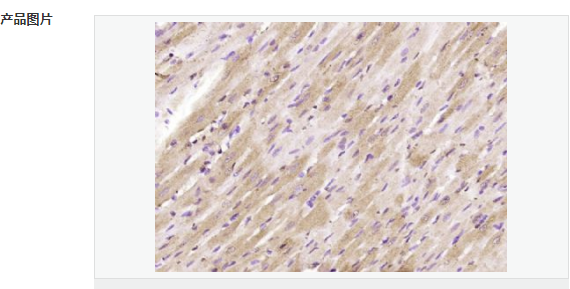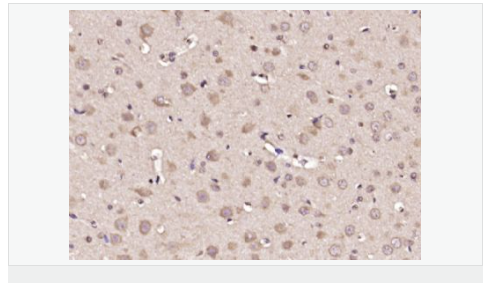
货号
产品规格
售价
备注
BN40672R-100ul
100ul
¥2360.00
交叉反应:Human,Rat(predicted:Mouse,Dog,Cow,Horse,Sheep) 推荐应用:IHC-P,IHC-F,ICC,IF,Flow-Cyt,ELISA
BN40672R-200ul
200ul
¥3490.00
交叉反应:Human,Rat(predicted:Mouse,Dog,Cow,Horse,Sheep) 推荐应用:IHC-P,IHC-F,ICC,IF,Flow-Cyt,ELISA
| 英文名称 | Glypican 1 |
| 中文名称 | 磷脂酰基醇蛋白聚糖1抗体 |
| 别 名 | FLJ38078; glypican; glypican1; GPC 1; Glypican-1; GPC1; Glypican proteoglycan 1; Gpc1; GPC1_HUMAN; Secreted glypican-1. |
| 研究领域 | 细胞生物 免疫学 |
| 抗体来源 | Rabbit |
| 克隆类型 | Polyclonal |
| 交叉反应 | Rat, (predicted: Mouse, Dog, Cow, Horse, Sheep, ) |
| 产品应用 | ELISA=1:5000-10000 IHC-P=1:100-500 IHC-F=1:100-500 ICC=1:100-500 IF=1:100-500 (石蜡切片需做抗原修复) not yet tested in other applications. optimal dilutions/concentrations should be determined by the end user. |
| 分 子 量 | 62kDa |
| 细胞定位 | 细胞浆 细胞膜 细胞外基质 分泌型蛋白 |
| 性 状 | Liquid |
| 浓 度 | 1mg/ml |
| 免 疫 原 | KLH conjugated synthetic peptide derived from mouse Glypican 1 :251-350/557 |
| 亚 型 | IgG |
| 纯化方法 | affinity purified by Protein A |
| 储 存 液 | 0.01M TBS(pH7.4) with 1% BSA, 0.03% Proclin300 and 50% Glycerol. |
| 保存条件 | Shipped at 4℃. Store at -20 °C for one year. Avoid repeated freeze/thaw cycles. |
| PubMed | PubMed |
| 产品介绍 | Cell surface heparan sulfate proteoglycans are composed of a membrane-associated protein core substituted with a variable number of heparan sulfate chains. Members of the glypican-related integral membrane proteoglycan family (GRIPS) contain a core protein anchored to the cytoplasmic membrane via a glycosyl phosphatidylinositol linkage. These proteins may play a role in the control of cell division and growth regulation. [provided by RefSeq, Jul 2008] Function: Cell surface proteoglycan that bears heparan sulfate. Binds, via the heparan sulfate side chains, alpha-4 (V) collagen and participates in Schwann cell myelination (By similarity). May act as a catalyst in increasing the rate of conversion of prion protein PRPN(C) to PRNP(Sc) via associating (via the heparin sulfate side chains) with both forms of PRPN, targeting them to lipid rafts and facilitating their interaction. Required for proper skeletal muscle differentiation by sequestering FGF2 in lipid rafts preventing its binding to receptors (FGFRs) and inhibiting the FGF-mediated signaling. Subcellular Location: Cell membrane; Lipid-anchor, GPI-anchor; Extracellular side. Endosome. Note=S-nitrosylated form recycled in endosomes. Localizes to CAV1-containing vesicles close to the cell surface. Cleavage of heparan sulfate side chains takes place mainly in late endosomes. Associates with both forms of PRNP in lipid rafts. Colocalizes with APP in perinuclear compartments and with CP in intracellular compartments. Associates with fibrillar APP Abeta peptides in lipid rafts in Alzheimer disease brains. Secreted glypican-1: Secreted, extracellular space. Post-translational modifications: S-nitrosylated in a Cu(2+)-dependent manner. Nitric acid (NO) is released from the nitrosylated cysteines by ascorbate or by some other reducing agent, in a Cu(2+) or Zn(2+) dependent manner. This free nitric oxide is then capable of cleaving the heparan sulfate side chains. N- and O-glycosylated. N-glycosylation is mainly of the complex type containing sialic acid. O-glycosylated with heparin sulfate. The heparan sulfate chains can be cleaved either by the action of heparanase or, degraded by a daaminative process that uses nitric oxide (NO) released from the S-nitrosylated cysteines. This process is triggered by ascorbate, or by some other reducing agent, in a Cu(2+)- or Zn(2+) dependent manner. Cu(2+) ions are provided by ceruloproteins such as APP, PRNP or CP which associate with GCP1 in intracellular compartments or lipid rafts. This cell-associated glypican is further processed to give rise to a medium-released species. DISEASE: Note=Associates (via the heparan sulfate side chains) with fibrillar APP-beta amyloid peptides in primitive and classic amyloid plaques and may be involved in the deposition of these senile plaques in the Alzheimer disease (AD) brain. Note=Misprocessing of GPC1 is found in fibroblasts of patients with Niemann-Pick Type C1 disease. This is due to the defective deaminative degradation of heparan sulfate chains. Similarity: Belongs to the glypican family. SWISS: Q9QZF2 Gene ID: 14733 Database links: Entrez Gene: 2817 Human Entrez Gene: 14733 Mouse Omim: 600395 Human SwissProt: P35052 Human SwissProt: Q9QZF2 Mouse Important Note: This product as supplied is intended for research use only, not for use in human, therapeutic or diagnostic applications. |


